Front matter |
Table of Contents |
Lorient |
Front matter |
Table of Contents |
Lorient |
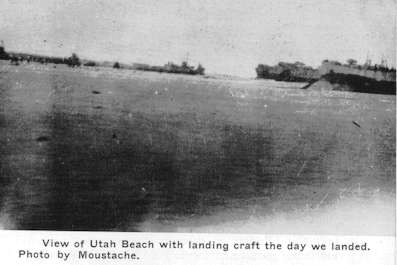 The
68th Tank Battalion had been well trained in the United States and the
United Kingdom. It had studied, maneuvered, and exercised long and assiduously
for the grim business of war. Commanders knew their men; the men knew their
jobs -- all this from training and the book. But, suddenly the chips were
down. We had just recently crossed the channel from England, and had regained
our land legs. We were ready. We were alerted; we wondered what sort of
a job was in store for us. Preparations were being quietly made, and we
all felt that something big was up to break through that stalemate down
by St. Lo and Lessay. And then, surely enough it began.
The
68th Tank Battalion had been well trained in the United States and the
United Kingdom. It had studied, maneuvered, and exercised long and assiduously
for the grim business of war. Commanders knew their men; the men knew their
jobs -- all this from training and the book. But, suddenly the chips were
down. We had just recently crossed the channel from England, and had regained
our land legs. We were ready. We were alerted; we wondered what sort of
a job was in store for us. Preparations were being quietly made, and we
all felt that something big was up to break through that stalemate down
by St. Lo and Lessay. And then, surely enough it began.
On July
28, 1944, at 1115, under Combat Command "A," we moved out from the vicinity
of Fierville toward Lessay. Company "A," commanded by Captain Raymond Polk,
was attached to the combat command advance guard under the 44th Armored
Infantry Battalion. Then after un-eventfully and successfully passing through
the 79th Infantry Division at Lessay, the Battalion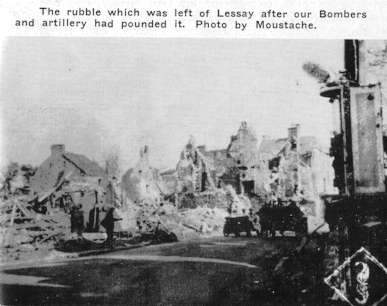 bivouacked
in the vicinity of Montsurvent. Thus the first day was over, and the big
move had begun, but the world had no inkling that the breakthrough was
under way. At 1040 the following day, the battalion moved out of its bivouac
area toward Pont de la Toque, when resistance was met by the head of the
column at Pont de la Roque, we moved off the road into a temporary assembly
and remained there until 2115, while the attack on the river crossing developed.
When the combat command deployed for the attack, one platoon of Company
"A," under the command of 2nd Lt. Donald A. Kratzer, was ordered to take
up direct fire positions on the high ground north of the Seine River, and
this fire was delivered on predesignated targets with excellent observed
results. Then, after the attack by the 44th was successful, this same platoon
forded the river under very difficult conditions and went into positions
to support the Infantry in case of counter-attack. At 2115, the Battalion
moved into bivouac one mile north of Pont de la Roque, and remained there
for the night.
bivouacked
in the vicinity of Montsurvent. Thus the first day was over, and the big
move had begun, but the world had no inkling that the breakthrough was
under way. At 1040 the following day, the battalion moved out of its bivouac
area toward Pont de la Toque, when resistance was met by the head of the
column at Pont de la Roque, we moved off the road into a temporary assembly
and remained there until 2115, while the attack on the river crossing developed.
When the combat command deployed for the attack, one platoon of Company
"A," under the command of 2nd Lt. Donald A. Kratzer, was ordered to take
up direct fire positions on the high ground north of the Seine River, and
this fire was delivered on predesignated targets with excellent observed
results. Then, after the attack by the 44th was successful, this same platoon
forded the river under very difficult conditions and went into positions
to support the Infantry in case of counter-attack. At 2115, the Battalion
moved into bivouac one mile north of Pont de la Roque, and remained there
for the night.
On the 30th of July, still under "CCA," we went into Division reserve, while elements of "CCB" passed through early in the morning. Then, at 2115, the battalion moved out again, and marched until dawn, at which time it closed bivouac near Muneville-Sur-Mer, where a successful operation was marred by the death of Pvt. William Wall, "A" Company, who was killed by a booby trap. Although our lightning strike up to this point had been veiled with secrecy, everyone knew that the outfit had broken into the clear, and from here on in it would be a question of stamina and some plain and fancy broken field running.
After only a few hours rest, the battalion moved out again and closed bivouac near La Tapiniere at 1415. Still driving hard and fast, we moved out again at 1900 and reached a point near Sartilly at 0315 the next morning. We were then under the control of the Third Army, destined to later and even soon cover itself with glory and also its colorful leader, Lt. General George Patton, Jr.
Early in the afternoon of the first of August, we headed for Avranches. After moving out we were strafed by enemy planes, and suffered one casualty. It was our first experience with strafing planes, and we shot at them perhaps a little indiscriminately. Perhaps the trigger finger was a little itchy. At 1930, the column was strafed again, this time south of Avranches, but we suffered no casualties. Then, we closed in bivouac shortly before midnight north of Antrain. The battalion S-2, Captain Raines, went forward to contact the FFI for information and found that they had cleared the town of enemy, and had seized and held an important bridge there, vitally necessary for the continued advance of the combat command. Our Reconnaissance Platoon, commanded by Lt. Harry Linebaugh in the meanwhile had reconnoitered for additional crossing of the river to be used in the event the bridge was blown. So ended another day, and we were really starting to roll.
At 0720 the next morning we continued the march, and swiftly steamed to a point near Medreac. Although we sidestepped most of it, we encountered scattered resistance, and captured during the day twelve prisoners, including one each [sic] badly confused Major. Also, "D" Company was strafed at 1410 by enemy planes firing rockets, but their accuracy was nil, and they were successfully driven off without any harm being done. The weather was ideal now, and, in spite of the strain of continual driving, we were in fine fettle and full of confidence. "CCB" was paralleling our spearhead and the enemy was in confused rout, that is, what remained of him, for we were well within his outer shell by this time. On the third of August, we moved out at 1225, Company
"A," marching with advance guard, had been receiving continuous small arms fire, but Captain Polk had found it necessary to use only limited deployment to clear the route of march. However, upon entering Mauron, one platoon, as part of the advance party encountered stiff small arms and cannon fire. So, with this platoon acting as a base of fire, the remainder of the company enveloped the town from the north. During this action, they destroyed several machine gun nests and caused heavy enemy casualties. As a result of this attack, what was left of this kraut force fell back from the town. And here's an interesting note -- for the first time we found that quite a few of the heinies were wearing Red Cross arm bands. Was Jerry getting a little desperate -- maybe? Well, when this action was completed, the battalion moved into bivouac one mile south of Mauron at 2200. At this time, one platoon, the second, of Company "D" was assigned to "CCA" trains for rear guard protection. Our supply, lines were stretching a wee bit.
At eight
o'clock the next morning, the battalion was detached from "CCA," as also
was the 44th AIB. Col. Davall was placed in command of this newly formed
force, and was ordered to remain in the area and await further orders,
and was also assigned Battery "A" of the 777th AAA Bn, but then at noon,
we reverted to "CCA" control again. Then Col. Davall was given the charge
of leading the combat command column, at 1350 we pulled out, heading west.
At Pontivy, the column ran into a blown bridge; there Sergeant Malcolm
Helton, later decorated with a Bronze Star for his action, reconnoitered
and found an alternate route across the river and canal, which permitted
the force to proceed with minimum loss of time. In order to accomplish
this, Sgt. Helton penetrated twenty miles, reportedly, into an area held
by the enemy, and used only one section to perform his hazardous mission.
With the column now in "free wheeling" we knifed our way sixty-one miles
beyond Mauron, where opposition was swiftly dealt with, the task force
refueled and remained along side the road to grab forty
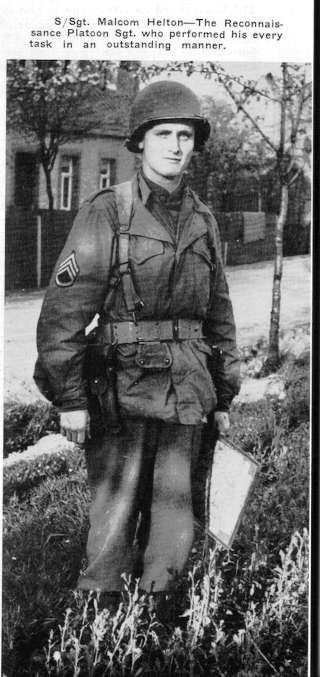 winks.
Thus ended one of the most daring, brilliantly led, under pressure armored
stabs made thus far in the march.
winks.
Thus ended one of the most daring, brilliantly led, under pressure armored
stabs made thus far in the march.
At nine thirty on the fifth of August, CCA resumed its westward trek under the command of Brig. General James Taylor. Then east of Merdrignac, Company "C" was fired on by organized sniper fire from a trench system. The company immediately returned fire, killing five enemy, and wounded many others. When the head of the column reached Huelgoat, Lt. Col. McCorrison was ordered by the Division Commander to clear the town, and two platoons of Company "A" were ordered to support one company of the 44th in accomplishing this mission. This force closed on the enemy in two directions and drove them into the northern end of the town. At this point, resistance grew very stiff, and the task force came to grips with the enemy at close quarters, One tank was hit by Panzerfaust fire at a very close range, and was set on fire, However, the tank crew remained inside and continued to machine gun the krauts until the heat became unbearable; crawling out of the vehicle they found themselves surrounded by Wehrmacht troops who called to them to surrender. Unanimously they refused, and immediately opened fire on the group in the face of overwhelming odds, and almost certain death. Technician 5th Grade, Santo De Nunziato, Fred K. Blaylock, were cut down by machine gun fire. Nunziato was immediately killed and Blaylock died of wounds later in the hospital. Technician 4th Grade Charles E. Pidcock continued to fire his sub-machine gun at close range until his tank exploded, and threw him into a nearby hedgerow. The enemy had been dissipated; all three tankers were later awarded the Silver Star for their gallantry in action. After the above action the column passed through the town of Huelgoat and bypassed the fighting, Company C commanded by Captain Daniel E. Smith was ordered to relieve Company A as part of the advance Guard. The actual transfer, however, did not take place until next morning, and that night enemy patrols infiltrated through a company bivouac area in the forward area, throwing grenades and causing one casualty before being driven off.
Then on the 6th of August, the 1st Platoon of D Company was attached to the advance guard to support the point. Also the third platoon of this company was attached to advance guard with the mission of reconnoitering an enemy strong point on the flank of the column. The third platoon proceeded on an independent route and encountered a road block defended by small arms, machine guns and bazookas, The platoon drew very heavy fire from all weapons, deployed and withdrew under their own supporting fire after inflicting heavy casualties and driving off some of the enemy machine guns and bazookas. This action cost the Company an important casualty, Captain Robert B. McKenna, Company Commander of Company "D," who was wounded in the left arm. The first platoon in the point encountered small arms, bazookas, and mortar fire while reconnoitering an enemy strong point while in the vicinity of the route march, but received no casualties. The main body moved out of the Bivouac area at approximately 1745.
Company C, now in the advance party, ran into stiff enemy resistance at Blouveaut, and came under fire from small arms, machine guns, mortars, and a battery of artillery. The enemy was dug in on well prepared positions. Enemy observation was good. However, a section of medium tanks, under the command of 2nd Lt. John Lundh, pushed into town and pressed the enemy back into the west end of town, while the CCA column bypassed the town and the strong point. This tank section knocked out two enemy machine gun nests and inflicted heavy personal casualties on the foe. It also admirably succeeded in screening the main body on the south end of the town, but the cost was heavy. Both tanks of the section were knocked out. Lt. Lundh's tank was knocked out by direct fire from a captured enemy French 75, and Sgt. Capozi's tank was knocked out by bazooka fire. The casualties were two killed, one wounded, and 4 missing.
At 2050 south of Plauveaut, when enemy artillery began to shell CCA column, 1st Lt. Elzie Hickerson went forward in an attempt to locate enemy guns and to direct our fire. In order to do this Lt. Hickerson had to go into the area where the fire was falling: this he did, and located the gun positions and remained there directing our counter-battery fire which immediately silenced the guns. For this action, Lt. Hickerson, the assault gun platoon leader, was later awarded the Bronze Star Medal. Thus the enemy was once more driven into headlong retreat. The Battalion finally closed in bivouac at 0200 the following morning in the vicinity of Gouesnou. Thus completed a continuous thirty-two hour march, which took the column through the towns of Bodtis and Plabennec.
Early in the morning of the 8th of August, the advance guard, to which was attached Company "C" and one platoon of Company "D," was heavily shelled by enemy artillery, direct fire and heavy mortar fire. Our vehicles were immobilized because of lack of gasoline; our drive had gone so far and so fast that our supply lines were stretched almost to the breaking point. Jerry had excellent observation, and his gun batteries were perfectly camouflaged; his ground troops were well dug in. And, although liaison planes vainly attempted to spot the concealed positions, our counter-battery fire was ineffective, and the merciless pounding continued for four and a half hours without respite.
During
this action many acts of heroism were noted; for example: Captain Daniel
E. Smith, Company Commander of Company "C" attempted to locate enemy installations,
boldly stood on tank and hedgerow, and so exposed himself on countless
occasions without concern for his personal safety. An Infantry attack was
expected; we needed better observation. Sensing this Captain Smith maintained
constant watch, paying no heed to the hail of shells bursting about him.
For this heroic conduct, he was later awarded the Silver Star Medal. Also,
Pfc. James T. Smith discovered that his buddy lay wounded in a slit trench;
he climbed on top of the turret of his tank to find the first aid kit.
A shell struck the turret and seriously wounded him. Despite his mortal
wounds, he secured the kit and crawled to the aid of his fallen comrade.
Then, after treating his buddy, he collapsed and was himself evacuated.
Several days later, he died in a field hospital. For his gallantry in action,
he was posthumously awarded the Silver Star Medal.
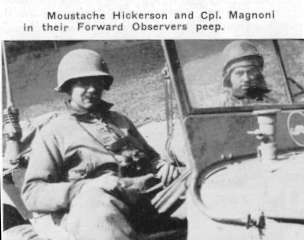 During
this costly action, our reconnaissance had further ascertained that we
had run into outer defenses of fortress BREST. The Division objective loomed
so near and yet so far. Our commanders followed the only logical course
-- withdrawal to more advantageous positions, stabilize our line, and prepare
to attack this strategically important port. It should be noted here that
the final reduction of Brest later proved to be a major military operation
requiring the committment of a corps reinforced and lasting several weeks.
And here we were -- having nearly completed a two hundred and fifty mile
piledriving breakthrough which had sapped our armored virility. The men
were tired. Then from higher headquarters came the order to our Battalion
"Attack and seize that portion of Brest which lies within your zone."
During
this costly action, our reconnaissance had further ascertained that we
had run into outer defenses of fortress BREST. The Division objective loomed
so near and yet so far. Our commanders followed the only logical course
-- withdrawal to more advantageous positions, stabilize our line, and prepare
to attack this strategically important port. It should be noted here that
the final reduction of Brest later proved to be a major military operation
requiring the committment of a corps reinforced and lasting several weeks.
And here we were -- having nearly completed a two hundred and fifty mile
piledriving breakthrough which had sapped our armored virility. The men
were tired. Then from higher headquarters came the order to our Battalion
"Attack and seize that portion of Brest which lies within your zone."
Automatically plans were made and we prepared for what we thought would be a last, futilely suicidal, sacrificial dash to glory,
As part of CCA, Task Force Davall was made up of the Battalion Reconnaissance Platoon, Battalion Headquarters, three subordinate assault forces, each composed of three medium tanks, one F.O.'s tank, one platoon of armored infantry, one tank destroyer. The Infantry was mounted on the tanks and T. D. The task force also had a reserve under 1st. Lt. Elzie Hickerson, which was composed of our 105mm Assault Gun Platoon, Mortar Platoon, the 44th AIB AT Platoon, and Engineer flame thrower squad, and an engineer mine detection squad. Remaining elements of the Battalion were also employed to form two other major Task Forces, similar in composition to Task Force Davall. One task force was under the command of Captain Raymond Polk, CO of Company "A." Also, the combat command reserve included Company "D" and service and administrative elements of the 68th.
After a lengthy artillery preparation, the attack jumped off at 0700 on the ninth of August. Task Force Davall was fired on by well placed 20mm dual-purpose ack-ack guns before it reached the line of departure, Our counterbattery silenced these guns, we knew exactly where they were, for 2nd Lt, Harry Linebaugh with elements of his platoon had reconnoitered, had even dangerously worked his way right up to the very gun muzzles the night before, and had pinpointed their location. Lt. Linebaugh was later awarded the Bronze Star Medal for this feat.
All Task Forces were working their way closer to the enemy's defensive position. Task Force Davall encountered a road block, and instantaneously began to outflank it, when suddenly there came over the radio the order to halt the attack and to withdraw. Whew! That was close! We were not disappointed that the attack was called off for everyone knew how enormous was the task, how well prepared he was to greet us on land, sea and air.
So, retaining
the composition of task forces, and under the control of CCA, Task Force
Davall marched to the vicinity of Plouvien. The Recon Platoon went forward
and found the town clear of enemy; the column turned west just south of
town and proceeded to its bivouac area, but before we had cleared this
turning point, fighting broke out in the streets. We later found out that
an enemy force of about 1500 members of the 265th Infantry Division had
approached Plouvien from the Northeast, unaware that we were there. Captain
Polk was Johnny-on-the-spot; he saw that the column's safe passage at this
critical point was seriously menaced. So, quickly he took a section of
his medium tanks into the town proper and contacted there a mixed group
of 44th and 9th AIB doughs, but no accompanying Officers, so he immediately
took command of the situation, He organized a tank-dough Task Force and
drove through the town until fire from enemy mortars, artillery and machine
guns became so severe that farther advance was impossible. In the meantime,
Lt. Col. McCorrison, CO of the 44th AIB had arrived on the scene, and it
was decided that Col McCorrison would press the attack in the original
direction while Captain Polk took a light Task Force around and whacked
the krauts from the west. Captain Polk, having sent for an additional section
of medium tanks, fought his way around through the west side of town and
pushed in the enemy right flank. The kraut force, finding itself pinched
in between the two attacking forces, withdrew from town and retreated up
the road, at which point our fighter planes dove into view and worked them
over. Needless to mention, for his display of courage and his initiative
and aggressiveness Captain Polk was awarded the Silver Star.
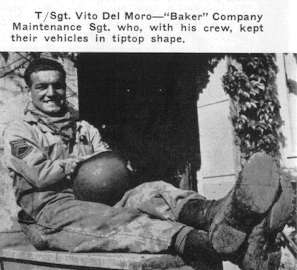 Also,
during the above action, we must tell what the outstanding soldiers under
Captain Polk achieved. Staff Sergeant Vernard T. Brock-Jones, and Sergeant
Myron N. Switzer, Platoon Sergeant and Section Leader respectively of the
section called up by Captain Polk to reinforce the original force, arrived
on the scene with orders to join an Infantry Platoon on the west side of
town. They found only two Infantrymen there, but immediately took enemy
positions under fire and fought their way forward. Infantrymen arrived
and they continued forward against heavy mortar, artillery and machine
gun fire. S/Sgt. Brock-Jones's tank was hit by bazooka fire, but he kept
going and kept pouring lead into the jerries until they were either mowed
down or flying out of town. Although un-hit, Sgt. Switzer did likewise,
and so both of these leaders were later awarded the Silver Stars for their
intrepid gallantry in the face of great odds.
Also,
during the above action, we must tell what the outstanding soldiers under
Captain Polk achieved. Staff Sergeant Vernard T. Brock-Jones, and Sergeant
Myron N. Switzer, Platoon Sergeant and Section Leader respectively of the
section called up by Captain Polk to reinforce the original force, arrived
on the scene with orders to join an Infantry Platoon on the west side of
town. They found only two Infantrymen there, but immediately took enemy
positions under fire and fought their way forward. Infantrymen arrived
and they continued forward against heavy mortar, artillery and machine
gun fire. S/Sgt. Brock-Jones's tank was hit by bazooka fire, but he kept
going and kept pouring lead into the jerries until they were either mowed
down or flying out of town. Although un-hit, Sgt. Switzer did likewise,
and so both of these leaders were later awarded the Silver Stars for their
intrepid gallantry in the face of great odds.
Then, after the smoke had cleared away and the battle was won, the 68th Tank Battalion went into bivouac for refueling and badly needed, much deserved rest. We remained in that location through the twelfth of August, recuperated and refitted as much as possible.
NOTE: Remove question mark from address below when sending email
This page is maintained by Bruce Frederick, EMAIL
.
Last updated: June 12, 1999.